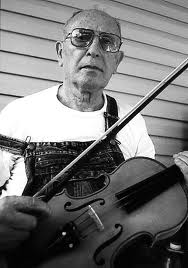Annotation:Cornstalk Fiddle
X:1 T:Cornstalk Fiddle and a Shoestring Bow M:4/4 L:1/8 R:Reel S:Clude Davenport (Ky.) Z:AK/Fiddler’s Companion K:G e2d2 BGBd|e2d2 g2 (ag)|e2d2 BdBG|A2G2G2z2| e2d2 BGBd|e2d2 g2 (ag)|e2d2 BdBG|A2G2G2|| D2G2 BGBG|A2G2 B3G|D2G2 BdBG|A2G2G2z2| D2G2 BGBG|A2G2 B2d|e2d BdBG|A2G2G2||
CORNSTALK FIDDLE (AND SHOESTRING BOW). Old-Time, Breakdown. USA; Kentucky, Mississippi, Arkansas. G Major: A Major. Standard tuning (fiddle). AABB. The title appears in a list of traditional Ozark Mountain fiddle tunes compiled by musicologist/folklorist Vance Randolph, published in 1954. It was recorded by Mississippi fiddler Frank Kittrell for the Library of Congress in 1939 (AFS LC 3035 B2). Although Davenport's tune is different from the tune called "Cotten Eyed Joe," the title "Cornstalk Fiddle" may be in some locales a floating or alternate name for "Cotten-Eyed Joe," a line of whose ditty goes:
Cornstalk fidde, shoestring bow,
Look out, Boys (or, 'Play a little tune'), says Cotten-Eyed Joe.

My bow's sugar, my bow's sweet;
My bow's sugar and she can't be beat.
Cornstalk fiddle and a shoestring bow (x4)
Jeff Titon (2001) says the second strain of Davenport's tune is similar to that of two other of his tunes: it is nearly identical to the second strain of "Sugar in My Coffee-O," and close to "Open the Gate and Walk on Through." Titon finds it a variant of "Grape Vine Twist (1)," a minstrel tune printed in the publications of Howe and Kerr in the 19th century. The melody also turns up in Lomax and Lomax's Our Singing Country (1941, pp. 68-69) in a song called "Bank of the Arkansas (The)," collected from a woman in Texas. "Cornstalk Fiddle" also has a similar melodic contour to “Prettiest Girl in the Country-o," particularly at the cadences, while the title comes from the first sung line in “Prettiest Girl in the Country-o”:
Cornstalk fiddle and a shoestring bow,
The best old fiddle in the county, Oh.
The lines can also be considered a 'floating' couplet (i.e. transferred to several old-time tune-songs). The couplet quoted above is from a text appearing in a WPA field collection made in Kentucky in 1936 [1].
- ↑ c.f. Stephen Green (“Title, Text and Tune Interrelations in American Fiddle Music," p. 23.

